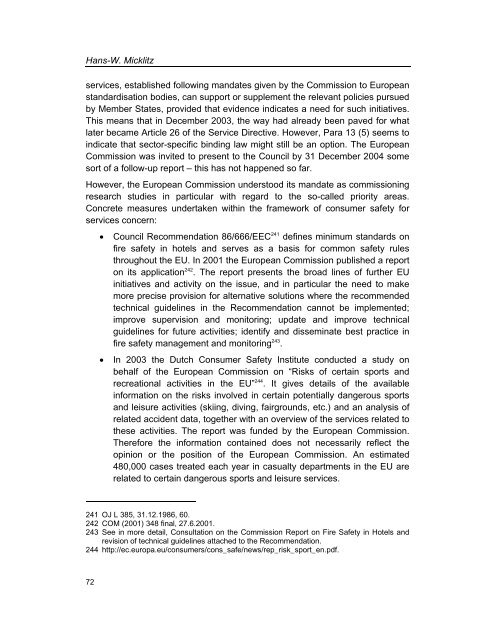Services Standards: Defining the Core Consumer Elements ... - ANEC
Services Standards: Defining the Core Consumer Elements ... - ANEC
Services Standards: Defining the Core Consumer Elements ... - ANEC
You also want an ePaper? Increase the reach of your titles
YUMPU automatically turns print PDFs into web optimized ePapers that Google loves.
Hans-W. Micklitz<br />
services, established following mandates given by <strong>the</strong> Commission to European<br />
standardisation bodies, can support or supplement <strong>the</strong> relevant policies pursued<br />
by Member States, provided that evidence indicates a need for such initiatives.<br />
This means that in December 2003, <strong>the</strong> way had already been paved for what<br />
later became Article 26 of <strong>the</strong> Service Directive. However, Para 13 (5) seems to<br />
indicate that sector-specific binding law might still be an option. The European<br />
Commission was invited to present to <strong>the</strong> Council by 31 December 2004 some<br />
sort of a follow-up report – this has not happened so far.<br />
However, <strong>the</strong> European Commission understood its mandate as commissioning<br />
research studies in particular with regard to <strong>the</strong> so-called priority areas.<br />
Concrete measures undertaken within <strong>the</strong> framework of consumer safety for<br />
services concern:<br />
• Council Recommendation 86/666/EEC 241 defines minimum standards on<br />
fire safety in hotels and serves as a basis for common safety rules<br />
throughout <strong>the</strong> EU. In 2001 <strong>the</strong> European Commission published a report<br />
on its application 242 . The report presents <strong>the</strong> broad lines of fur<strong>the</strong>r EU<br />
initiatives and activity on <strong>the</strong> issue, and in particular <strong>the</strong> need to make<br />
more precise provision for alternative solutions where <strong>the</strong> recommended<br />
technical guidelines in <strong>the</strong> Recommendation cannot be implemented;<br />
improve supervision and monitoring; update and improve technical<br />
guidelines for future activities; identify and disseminate best practice in<br />
fire safety management and monitoring 243 .<br />
• In 2003 <strong>the</strong> Dutch <strong>Consumer</strong> Safety Institute conducted a study on<br />
behalf of <strong>the</strong> European Commission on “Risks of certain sports and<br />
recreational activities in <strong>the</strong> EU” 244 . It gives details of <strong>the</strong> available<br />
information on <strong>the</strong> risks involved in certain potentially dangerous sports<br />
and leisure activities (skiing, diving, fairgrounds, etc.) and an analysis of<br />
related accident data, toge<strong>the</strong>r with an overview of <strong>the</strong> services related to<br />
<strong>the</strong>se activities. The report was funded by <strong>the</strong> European Commission.<br />
Therefore <strong>the</strong> information contained does not necessarily reflect <strong>the</strong><br />
opinion or <strong>the</strong> position of <strong>the</strong> European Commission. An estimated<br />
480,000 cases treated each year in casualty departments in <strong>the</strong> EU are<br />
related to certain dangerous sports and leisure services.<br />
241 OJ L 385, 31.12.1986, 60.<br />
242 COM (2001) 348 final, 27.6.2001.<br />
243 See in more detail, Consultation on <strong>the</strong> Commission Report on Fire Safety in Hotels and<br />
revision of technical guidelines attached to <strong>the</strong> Recommendation.<br />
244 http://ec.europa.eu/consumers/cons_safe/news/rep_risk_sport_en.pdf.<br />
72
















